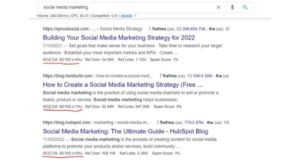The Method Episode #21

How To Beat Your Competition On Google
This is a dry one, but handy to know if your business relies on website marketing.
MOZ (A SEO SaaS tool) has created this thing called domain authority (D/A). It’s a search engine ranking score that predicts how likely a website is to rank in search engine result pages (SERPs).
The theory is (according to Moz) that the higher your website’s D/A score is, the higher it will show up in google search results. The tool scores every website from 0 to 100. High authority websites like Facebook score in the high 90s, and brand new websites score 0.
So say, for example, you search ‘social media marketing‘ in google – the results (websites) you see on the first page of google will have high D/A scores ~80+.

Roughly speaking, if you want people to see your website before your competitors on Google, you need a higher D/A than theirs. This isn’t always the case, a low D/A site can out-rank a high D/A site for other reasons – but generally, it works.
And you can increase the domain authority of your website by building backlinks, which is simply a link from someone else’s website to yours.
The quickest and easiest way to start increasing your website’s domain authority is by adding your business to online business directories followed by industry-specific business directories.
For example – a general business directory is google my business, or an industry-specific business directory is Yelp (Restaurants).
To find them, google ‘business directory’ or ‘restaurant directory’ and start submitting your website.

Why We Might Aspire To Build The Perfect Product
“You’re doing sales because you failed at marketing. You’re doing marketing because you failed at product.” – Naval Ravikant.
This tweet by Naval has coped a lot of heat.
Many thought he implied they had failed (as an entrepreneur) if they relied on marketing or sales. No, he’s simply saying if you nail products, you won’t need marketing or sales to grow, and you can rely on word of mouth instead.
What’s most interesting about this tweet is the aspirational framework Naval is presenting here that we can use to navigate the early stages of building businesses.
I’ve never created anything good enough that doesn’t need marketing. But I think that’s a goal many of us have, even if we don’t realise it yet.
In startup jargon, the term used to define how good a product meets the expectations of its customers is called product-market fit. And supposedly, if you get product-market fit just right, your product is good enough to sell itself.
So you might say that companies who grow without sales and marketing have reached perfect PMF and can rely solely on word of mouth to grow.
Inverting Navals tweet. The general framework then is when launching something new – start with sales, then extend to marketing, then eventually (when you’ve found the perfect product-market fit) you can rely on product/word of mouth.
Or, as Paul Graham likes to say to the early stage founders of Y Combinator – do things that don’t scale.
If you’re wondering how to measure product-market fit, you can use the NPS tool we talked about in episode #19.
“You have your way. I have my way. As for the right way, the correct way, and the only way, it does not exist.”
~ Friedrich Wilhelm Nietzsche
Where We’re Learning
• Most startups aren’t startups -> This article with the help of Paul Grahams groundwork exposes the myth of the startup. Realistically very few businesses are startups – most are just small businesses trying to become bigger ones.

Building Fast Money Vs Long-Term Money
From small Mum and Pop shops to fortune 500 companies, one number on the PnL sheet (profit and loss statement) excites us more than all others – growth rate.
If you’re not familiar, the growth rate is the rate at which revenue increases, generally year on year in a business. So if revenue increases from $100,000 to $150,000 in a year, the growth rate is 50%.
High growth startups get higher valuations. High growth stocks have higher price-earnings ratios. High growth businesses sell for higher EBITDA multiples.
Why? Growth rate signals potential. Young businesses with a big potential market to capture grow fast – Like Uber circa 2015. Mature businesses that dominate their market grow slower, like Walmart now.
It’s a proxy that generally works. Most companies growing at say 10% a year are either already big or will never get big. While companies growing at 300% a year often become huge.
What this growth rate proxy doesn’t account for, though, is a company’s long-term viability. A 10% growth rate isn’t impressive. But a 10% growth sustained for 50 years is a 117x increase.
The takeaway here is twofold.
You can chase fast wealth and get the best bang for your buck relative to the time you’ve invested by building a high growth company and selling at the peak of said company’s growth. But there are very few opportunities like this – a low percentage chance.
Or you can pursue an opportunity that offers a reasonable, sustainable growth rate and build an equally large amount of wealth over a longer period of time. And there are many opportunities like this – a high percentage chance.


